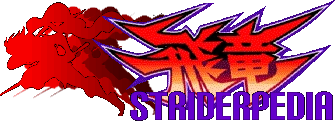Strider is a port of the original coin-op onto the 8-bit Sega Master System. The game was published by Sega, much like the Mega Drive port that preceded it (even carrying the same "Reprogrammed Game" label in the title screen) and developed by British company Tiertex[1]. Tiertex converted it from their previous home computer ports, in the process keeping some of their unique elements such as the second title screen (which uses the same Solo/Hiryu artwork and stylized "Strider" logo) and the ending, which states the whole game is a simulation Hiryu took before facing the "real invasion". As a result this port lacks the same quality of its Mega Drive counterpart, suffering from spotty programming, awkward physics and subpar graphics.
Outside the altered ending, in terms of story, the game's manual includes the same prologue used in the Mega Drive port, albeit shortened. In-game cutscenes, however, have been completely and nonsensically rearranged from the original game, mixing dialogues and image portraits with no rhyme or reason. The most notable example of this is the appearance of the Amazoness saying "Nobody goes against the Master!" in each cutscene.
This port was never released in Japan.
Differences with the Arcade
As stated above, the game plays nothing like the original arcade, and looks subpar even for the console's standards. Graphics lack vibrant colors and details, with most stages sporting a bland black background as sky. The palette selection is atrocious, rendering stuff like the snow purplish and Hiryu's belt green rather than silver. Animation looks clunky, with several missing frames and noticeable flickering, which turns even worse against the bosses. In terms of gameplay, Hiryu's movement and jumping speed is half of what they are in the coin-op. There are noticeable issues with the physics when jumping or doing a cartwheel jump, and certain areas feel like there's no gravity at all. Other issues like invisible midair platforms plague the game throughout its course.
List of Changes
- Hiryu starts out with 4 hit points instead of 3.
- Several power-up items are missing.
- Really slow gameplay and progression, including noticeable slowdown when moving and falling.
- Fewer onscreen enemies.
- Some objects and enemies have different score and HP allocations.
- Out of the three Options, only the Dipodal Saucer remains.
- Missing "Slide" technique.
- Stages have been redesigned extensively. Whole areas have been removed, alternate paths no longer exist and structures are simplified and streamlined.
- The boss fights against Strobaya and Solo cannot be avoided.
- The boss battle against the Kuniang team is missing from both Stage 2 and 5. All bosses from the last stage are also entirely missing save for Mecha Pon.
- Boss patterns have been simplified extensively: Ouroboros simply dashes across the edges of the room and can't be climbed up, giant bosses Mecha Pon and Lago have lost all their animations and are simple stationary enemies with a single attack, etc.
- A final battle against Grandmaster Meio has been hastily implemented, probably due to it being missing from all other Tiertex conversions. His sprite is ripped from the Arcade game's intro sequence, resulting in a giant Meio that dwarfs Hiryu in size. His boss room is separate from the final stage (the stage ends after beating Mecha Pon, then loads Meio's battle after calculating the score) and he simply stands in its center lobbing energy orbs at Hiryu.
Screenshots
References
- ↑ 1.0 1.1 Regan, Matt. Rignall, Julian (March 1991). "Strider - Review". Mean Machines (06). Pg 64.
- ↑ LinkedIn Profile: Paul Marshall. Linkedin.com. Accessed 22 Dec 2012.
| Strider video game series |
|---|
| Games |
| Strider (Home computers • Mega Drive • Master System • PC Engine • Sharp X68000 • PlayStation • Mobile) Strider (NES) • Strider II/Returns • Strider 2 • Strider (2014) Compilations • Crossovers • Related Games |
| Characters |
| Hiryu • Grandmaster Meio • Solo • Kuniang M.A. Team Tong Pooh • Hien • General Mikiel • Ouroboros |
| Recurring Elements |
| Striders • Cypher • Climb Sickle • Options • Kazakh Federation Anti-Gravity Device/Gravitron • Mecha Pon • Flying Battleship Balrog • The Third Moon |
| Other Articles |
| Capcom • Moto Kikaku • Tiertex Design Studios • Double Helix Games Isuke • Patariro • Other key staff • Strider Hiryu (Manga) • Capcom Gamebooks Merchandise • Soundtracks |










